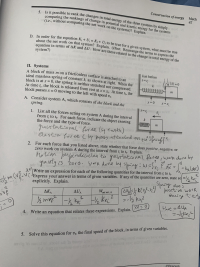
College Physics
11th Edition
ISBN: 9781305952300
Author: Raymond A. Serway, Chris Vuille
Publisher: Cengage Learning
expand_more
expand_more
format_list_bulleted
Question
thumb_up100%
Could you help with 4 and 5?

Transcribed Image Text:### Conservation of Energy
#### 5. Is it possible to rank the changes in total energy of the three systems by simply comparing the rankings of the change in potential and kinetic energy for the systems (i.e., without comparing the net work on the systems)? Explain.
#### D. In order for the equation \( K_i + U_i = K_f + U_f \) to be true for a given system, what must be true about the net work on that system? Explain. (Hint: Rearrange the terms to express the equation in terms of \(\Delta K\) and \(\Delta U\). How are these related to the change in total energy of the system?)
---
### II. Systems
A block of mass \( m \) on a frictionless surface is attached to an ideal massless spring of constant \( k \), as shown in the diagram below.
**Diagram Description:**
- The block is initially at \( x = 0 \), the spring is neither stretched nor compressed.
- At time \( t_i \), the block is released from rest at \( x = x_i \).
- At time \( t_f \), the block passes \( x = 0 \) moving to the left with speed \( v_f \).
- **Just Before Diagram** shows the block at \( x = x_i \) with the spring compressed/stretched.
- **t = t_f, x = 0** shows the block passing the equilibrium position.
---
#### A. Consider system A, which consists of the block and the spring.
**1. List all the forces acting on system A during the interval from \( t_i \) to \( t_f \). For each force, indicate the object exerting the force and the type of force.**
- Gravitational force (by Earth)
- Normal force (by surface)
- Spring force (by spring)
**Notes** (as per handwritten annotations):
- Gravitational force perpendicular to gravitational work is zero.
- Work done by spring: \( W = \int_{x_i}^{0} -kx\, dx = -\frac{1}{2}kx_i^2 \)
**2. For each force that you listed above, state whether that force does positive, negative, or zero work on system A during the interval from \( t_i \) to \( t_f \). Explain.**
- Gravitational force: zero work.
- Normal force: zero
Expert Solution
This question has been solved!
Explore an expertly crafted, step-by-step solution for a thorough understanding of key concepts.
This is a popular solution
Trending nowThis is a popular solution!
Step by stepSolved in 3 steps with 2 images

Knowledge Booster
Learn more about
Need a deep-dive on the concept behind this application? Look no further. Learn more about this topic, physics and related others by exploring similar questions and additional content below.Similar questions
- Determine the angle 0 between the 350-lb force and the line OC.arrow_forward"What is the angle between two vectors A and B given that Ax =3, Ay = -2, Bx =2, and By =3?"arrow_forward30 N 40 N 20 N A' 10 N The above figure indicates O a net force of 28.3 N along the diagonal CA O a net downward force of 20 N an equilibrium of the reactangular slab O a net leftward force of 20 Narrow_forward
arrow_back_ios
arrow_forward_ios
Recommended textbooks for you
 College PhysicsPhysicsISBN:9781305952300Author:Raymond A. Serway, Chris VuillePublisher:Cengage Learning
College PhysicsPhysicsISBN:9781305952300Author:Raymond A. Serway, Chris VuillePublisher:Cengage Learning University Physics (14th Edition)PhysicsISBN:9780133969290Author:Hugh D. Young, Roger A. FreedmanPublisher:PEARSON
University Physics (14th Edition)PhysicsISBN:9780133969290Author:Hugh D. Young, Roger A. FreedmanPublisher:PEARSON Introduction To Quantum MechanicsPhysicsISBN:9781107189638Author:Griffiths, David J., Schroeter, Darrell F.Publisher:Cambridge University Press
Introduction To Quantum MechanicsPhysicsISBN:9781107189638Author:Griffiths, David J., Schroeter, Darrell F.Publisher:Cambridge University Press Physics for Scientists and EngineersPhysicsISBN:9781337553278Author:Raymond A. Serway, John W. JewettPublisher:Cengage Learning
Physics for Scientists and EngineersPhysicsISBN:9781337553278Author:Raymond A. Serway, John W. JewettPublisher:Cengage Learning Lecture- Tutorials for Introductory AstronomyPhysicsISBN:9780321820464Author:Edward E. Prather, Tim P. Slater, Jeff P. Adams, Gina BrissendenPublisher:Addison-Wesley
Lecture- Tutorials for Introductory AstronomyPhysicsISBN:9780321820464Author:Edward E. Prather, Tim P. Slater, Jeff P. Adams, Gina BrissendenPublisher:Addison-Wesley College Physics: A Strategic Approach (4th Editio...PhysicsISBN:9780134609034Author:Randall D. Knight (Professor Emeritus), Brian Jones, Stuart FieldPublisher:PEARSON
College Physics: A Strategic Approach (4th Editio...PhysicsISBN:9780134609034Author:Randall D. Knight (Professor Emeritus), Brian Jones, Stuart FieldPublisher:PEARSON

College Physics
Physics
ISBN:9781305952300
Author:Raymond A. Serway, Chris Vuille
Publisher:Cengage Learning

University Physics (14th Edition)
Physics
ISBN:9780133969290
Author:Hugh D. Young, Roger A. Freedman
Publisher:PEARSON

Introduction To Quantum Mechanics
Physics
ISBN:9781107189638
Author:Griffiths, David J., Schroeter, Darrell F.
Publisher:Cambridge University Press

Physics for Scientists and Engineers
Physics
ISBN:9781337553278
Author:Raymond A. Serway, John W. Jewett
Publisher:Cengage Learning

Lecture- Tutorials for Introductory Astronomy
Physics
ISBN:9780321820464
Author:Edward E. Prather, Tim P. Slater, Jeff P. Adams, Gina Brissenden
Publisher:Addison-Wesley

College Physics: A Strategic Approach (4th Editio...
Physics
ISBN:9780134609034
Author:Randall D. Knight (Professor Emeritus), Brian Jones, Stuart Field
Publisher:PEARSON